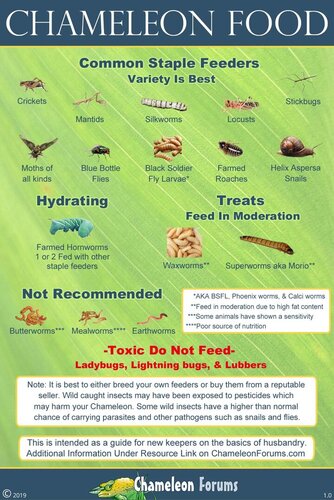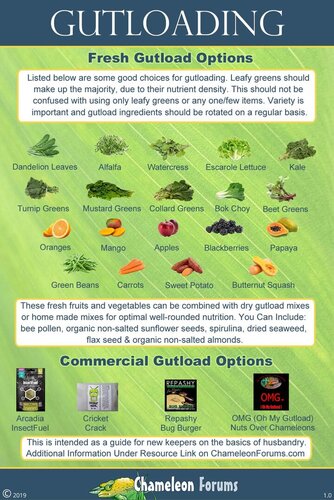Navigation
Install the app
How to install the app on iOS
Follow along with the video below to see how to install our site as a web app on your home screen.
Note: This feature may not be available in some browsers.
More options
You are using an out of date browser. It may not display this or other websites correctly.
You should upgrade or use an alternative browser.
You should upgrade or use an alternative browser.
Complete List?
- Thread starter animal__lover
- Start date
animal__lover
New Member
Ok thanks!Dubia are good high protein. Crickets locusts bsfl silkworms staple feeders . Wax worms and morio treats. Hornworms treats / hydration
ERKleRose
Chameleon Enthusiast
Filling out the ask for help form with everything you plan to use would be great! Keep in mind that cage is the minimum size required, so definitely try to go bigger! Those basking temps are for adults, so remember that. Also the basking temp shouldn’t exceed 87*F as the max. Make sure the basking spot is a few degrees lower since chameleons add height to diminish the distance. Where the chameleon’s head is shouldn’t really be past 85-86/87*F, unless he is too cold. If he is too hot once you get him, lower the wattage or raise the bulb farther away. If he’s too cold, bring the bulb closer or raise the wattage. The ambient temp at the bottom of the cage should really be 75*F at its max. A good gradient is needed for chameleons to properly thermoregulate themselves. Your UVB bulb strength needs to be either Arcadia 6% (replace once a year or when UVI ratings are cut in half) or Zoo Med 5.0 (replace every six months or when UVI ratings are cut in half). Absolutely get at least the UVI Solarmeter, if not the UVB one as well! The T5 HO fixture itself should be either the length of the enclosure or a foot longer and needs to go over the middle of the cage. Climist’s misting systems can be used as well. They’re the same quality as MistKings but are usually a little cheaper, if you want to save some money. Make sure to use RO/DI (reverse osmosis distilled water) water for all drippers, misters, and humidifiers/foggers. Superworms should be used as treats, not a staple, along with hornworms. Hornworms are fatty but provide a great hydration boost! Use as many gutload ingredients as you can! I’ll post the feeder and gutload images at the end. If you want to save a little money and simplify your supplement schedule, just get and use Zoo Med Reptivite with D3 once every two weeks and Zoo Med Repticalcium without D3 on every feeding except for when it’s time to use the Reptivite with D3.Ok so after a lot of Neptune the Chameleon videos, here is what I've got!
So what do you think?
- I need a 2'x2'x4' screen cage
- Heat bulb with a basking spot at 85-90 degrees (and an ambient temp of 75-80 degrees) Don't use a red light
- A Linear T5 HO UBV
- Both lights on 12 hrs. & off 12 hrs.
- They need a 50%-70% humidity
- A misting system (MistKing is best) on twice a day for 3-5 minutes
- A dripper for hydration (either a DIY or store bought)
- A good diet can be superworms, crickets, hornworms, Dubia roaches, and they need variety
- You must gutload the insects. Some good options are kale, mango, carrots, apple, leafy greens, etc.
- Feeding in the morning is ideal
- They need three supplements: Calcium with NO D3, Calcium WITH D3, and a multivitamin. (P.S. I have a schedule from Neptune the Chameleon, its just rlly long to write lol)
Attachments
Shanar808
Avid Member
Depending on your plants you nights want a plant light too, I use a t5 6500k grow light next to my t5 uvb in a dual fixture. With panthers or veileds you would need live plants so this is important to help keep them alive. CaskAbove has a great website that would help you with setup. I also find that my humidifier (rigged to a hose to become a fogger) is where my chameleon gets majority of her hydration.Ok so after a lot of Neptune the Chameleon videos, here is what I've got!
So what do you think?
- I need a 2'x2'x4' screen cage
- Heat bulb with a basking spot at 85-90 degrees (and an ambient temp of 75-80 degrees) Don't use a red light
- A Linear T5 HO UBV
- Both lights on 12 hrs. & off 12 hrs.
- They need a 50%-70% humidity
- A misting system (MistKing is best) on twice a day for 3-5 minutes
- A dripper for hydration (either a DIY or store bought)
- A good diet can be superworms, crickets, hornworms, Dubia roaches, and they need variety
- You must gutload the insects. Some good options are kale, mango, carrots, apple, leafy greens, etc.
- Feeding in the morning is ideal
- They need three supplements: Calcium with NO D3, Calcium WITH D3, and a multivitamin. (P.S. I have a schedule from Neptune the Chameleon, its just rlly long to write lol)
animal__lover
New Member
Amazing thank you!Filling out the ask for help form with everything you plan to use would be great! Keep in mind that cage is the minimum size required, so definitely try to go bigger! Those basking temps are for adults, so remember that. Also the basking temp shouldn’t exceed 87*F as the max. Make sure the basking spot is a few degrees lower since chameleons add height to diminish the distance. Where the chameleon’s head is shouldn’t really be past 85-86/87*F, unless he is too cold. If he is too hot once you get him, lower the wattage or raise the bulb farther away. If he’s too cold, bring the bulb closer or raise the wattage. The ambient temp at the bottom of the cage should really be 75*F at its max. A good gradient is needed for chameleons to properly thermoregulate themselves. Your UVB bulb strength needs to be either Arcadia 6% (replace once a year or when UVI ratings are cut in half) or Zoo Med 5.0 (replace every six months or when UVI ratings are cut in half). Absolutely get at least the UVI Solarmeter, if not the UVB one as well! The T5 HO fixture itself should be either the length of the enclosure or a foot longer and needs to go over the middle of the cage. Climist’s misting systems can be used as well. They’re the same quality as MistKings but are usually a little cheaper, if you want to save some money. Make sure to use RO/DI (reverse osmosis distilled water) water for all drippers, misters, and humidifiers/foggers. Superworms should be used as treats, not a staple, along with hornworms. Hornworms are fatty but provide a great hydration boost! Use as many gutload ingredients as you can! I’ll post the feeder and gutload images at the end. If you want to save a little money and simplify your supplement schedule, just get and use Zoo Med Reptivite with D3 once every two weeks and Zoo Med Repticalcium without D3 on every feeding except for when it’s time to use the Reptivite with D3.
Klyde O'Scope
Chameleon Enthusiast
Can someone make a chameleon owner shopping list for a new owner? Like, everything I will need to buy or what you bought? It can be confusing to find info
I think that's not exactly a "shopping list." Without addressing completeness (there's a lot missing), let's go through your list. I've changed the bullets to numbers for clarity & reference.Ok so after a lot of Neptune the Chameleon videos, here is what I've got!
So what do you think?
- I need a 2'x2'x4' screen cage
- Heat bulb with a basking spot at 85-90 degrees (and an ambient temp of 75-80 degrees) Don't use a red light
- A Linear T5 HO UBV
- Both lights on 12 hrs. & off 12 hrs.
- They need a 50%-70% humidity
- A misting system (MistKing is best) on twice a day for 3-5 minutes
- A dripper for hydration (either a DIY or store bought)
- A good diet can be superworms, crickets, hornworms, Dubia roaches, and they need variety
- You must gutload the insects. Some good options are kale, mango, carrots, apple, leafy greens, etc.
- Feeding in the morning is ideal
- They need three supplements: Calcium with NO D3, Calcium WITH D3, and a multivitamin. (P.S. I have a schedule from Neptune the Chameleon, its just rlly long to write lol)
- Whether screen or hybrid depends on (among other things) ambient (your household) temps & RH. "All-screen" may appear to be the least expensive option, but it may not necessarily be the best option for your cham and lifestyle (and hopefully this cham will be with you for many years). If you need to make modifications to achieve proper climate, it could cost as much as going with a hybrid from the get-go.
- What are you going to screw the basking bulb into? IOW, you're also going to need a fixture, a way to mount or suspend it above the enclosure, and possibly an extension cord.
- Assuming that includes a fixture.
- That means at least one timer.
- Digital hygrometer with probe—possibly more than one.
- Schedule aside, you may need an additional mist head; MK Starter kit only comes with one. You'll also need a reservoir of some kind; MK systems don't come with reservoirs either.
- Depending on your modified misting schedule, a dripper may be superfluous.
- Good, but they're more of a continuing expense I think better addressed separately.
- Ditto.
- Not a "shopping list" item.
- Good.
- Live plants: which ones, how many.
- Organic potting soil
- Stones to cover the plant pots.
- Plant food
- If not all sitting on the enclosure floor (which is fine), will you need a way to hang/mount plants
- Plant Lights (plus bulbs, fixtures, mounting/hanging hardware) UVB & basking lamps will not be enough.
- Digital thermometers with probes (at least 2—may be combined with hygrometers)
- Branches & other climbing apparatus, and a way to attach, mount, or suspend. This could be something as elaborate as dragon ledges, or a less expensive DIY arrangement.
- Zip-ties
- Feeder run cup
- Drainage—may depend on the enclosure. Some enclosures come with drain pans—others don't—and you'll still need a way to remove excess water, like...
- Drainage bucket
- Reservoir for MK
- Distilled or RO water for misting system. This is an ongoing expense, but you'll need at least one gallon to set up, test, & aim the mist heads.
- Highly recommended: IR Thermometer (temp gun) and UVI meter.
I'm also sure others here will have input I missed, alternatives, etc.
Last edited:
Similar threads
- Replies
- 11
- Views
- 1K
- Replies
- 15
- Views
- 2K




